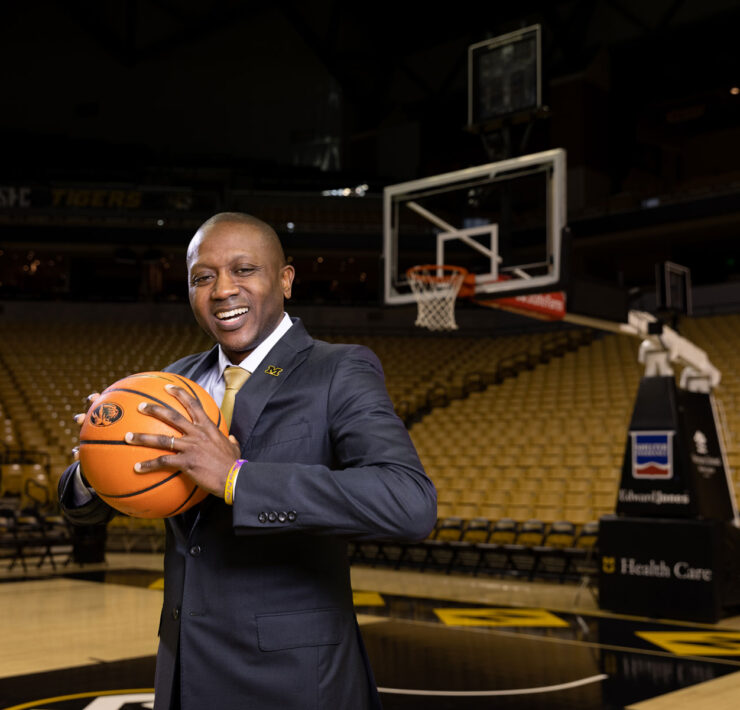Rex L. Sharp, MU associate athletic director/sports medicine
 How many trainers do you employ? Our Mizzou Athletic Training staff has continued to grow as the comprehensive scope of the athletic program has grown. When I arrived in 1996, the MU Athletic Training staff consisted of four full-time certified athletic trainers, three certified athletic training graduate students and eight undergraduate student athletic trainers. Presently, we have 12 full-time certified athletic trainers, six certified graduate assistant athletic trainers and an exciting new undergraduate athletic training program of study that has an enrollment of 36 undergraduate athletic training students. The athletic training program is in its infancy, and all 36 of our students are sophomores.
How many trainers do you employ? Our Mizzou Athletic Training staff has continued to grow as the comprehensive scope of the athletic program has grown. When I arrived in 1996, the MU Athletic Training staff consisted of four full-time certified athletic trainers, three certified athletic training graduate students and eight undergraduate student athletic trainers. Presently, we have 12 full-time certified athletic trainers, six certified graduate assistant athletic trainers and an exciting new undergraduate athletic training program of study that has an enrollment of 36 undergraduate athletic training students. The athletic training program is in its infancy, and all 36 of our students are sophomores.
How many athletes do you oversee? My primary clinical athletic training responsibility is with the Mizzou Football program, making for direct oversight of 127 student athletes. By virtue of being the director of sports medicine, or whatever title may apply, I oversee the athletic health care needs for all 540 student athletes.
Do your trainers specialize in one sport? We have a very diverse, well-rounded group of athletic trainers at Mizzou. Although each staff member may concentrate his or her clinical efforts with his or her assigned intercollegiate sport, each is well prepared to work with or assist with other sports as needed. I have always subscribed to the philosophy of hiring good, well-trained, energetic people and providing the resources they need to perform their job functions at a high level.
What sports teams see the most injuries, in total? By sheer volume of numbers of participants and injury exposures, fall football easily accounts for the highest number of injuries/illnesses. In fact, as a program we average three injuries/illnesses per day for the entire year. That accounts for some numbers. Track and field and spring football are second and third, respectively. However, the sport that experiences the highest injury rate per participant is women’s gymnastics.
What is the most common injury for the football team? Basketball? Softball? Gymnastics? Others? In my experience, injuries are cyclical. Some years we have more knee injuries, some years ankle injuries and some years shoulder injuries. Between the collaborative efforts of the MU Team Physicians, headed by Dr. Patrick A. Smith; the Athletic Performance Staff, headed by Pat Ivey; the Athletic Training staff; the sport coaching staff; and our team of other allied health care professionals, we try to prevent as many injuries as possible. However, injuries are inevitable with the year-round training/competition that minimizes the chance for recovery and regeneration of the body.
Is there a trainer present at every practice and game, or are they just on call? At least one staff athletic trainer is present at each practice and competition, and with the accessibility provided by cellphones, our staff is on call 24 hours every day, all year.
What is something most people are surprised to know about this profession? Athletic trainers are often perceived as a hybrid between strength coaches and personal fitness trainers, when in reality, athletic trainers are licensed health care professionals primarily focusing on three very important components: athletic injury prevention; athletic injury evaluation, treatment and management; and athletic injury rehabilitation. Prevention starts with ensuring the athlete has a thorough preparticipation history, screening and physical examination. Prevention also involves substance-abuse screening and education, designing and organizing venue-specific emergency action procedures to be activated in the event of a serious injury, monitoring the safety of extreme environmental conditions and preventive taping (ankle taping/knee taping, etc.). In addition to prevention, athletic trainers are responsible for the acute and post-acute treatment and management of injuries and serve as referral sources for physical and mental health consultations and the overall organization and administration of a comprehensive athletic health care program that makes athletic participation as safe as possible.



